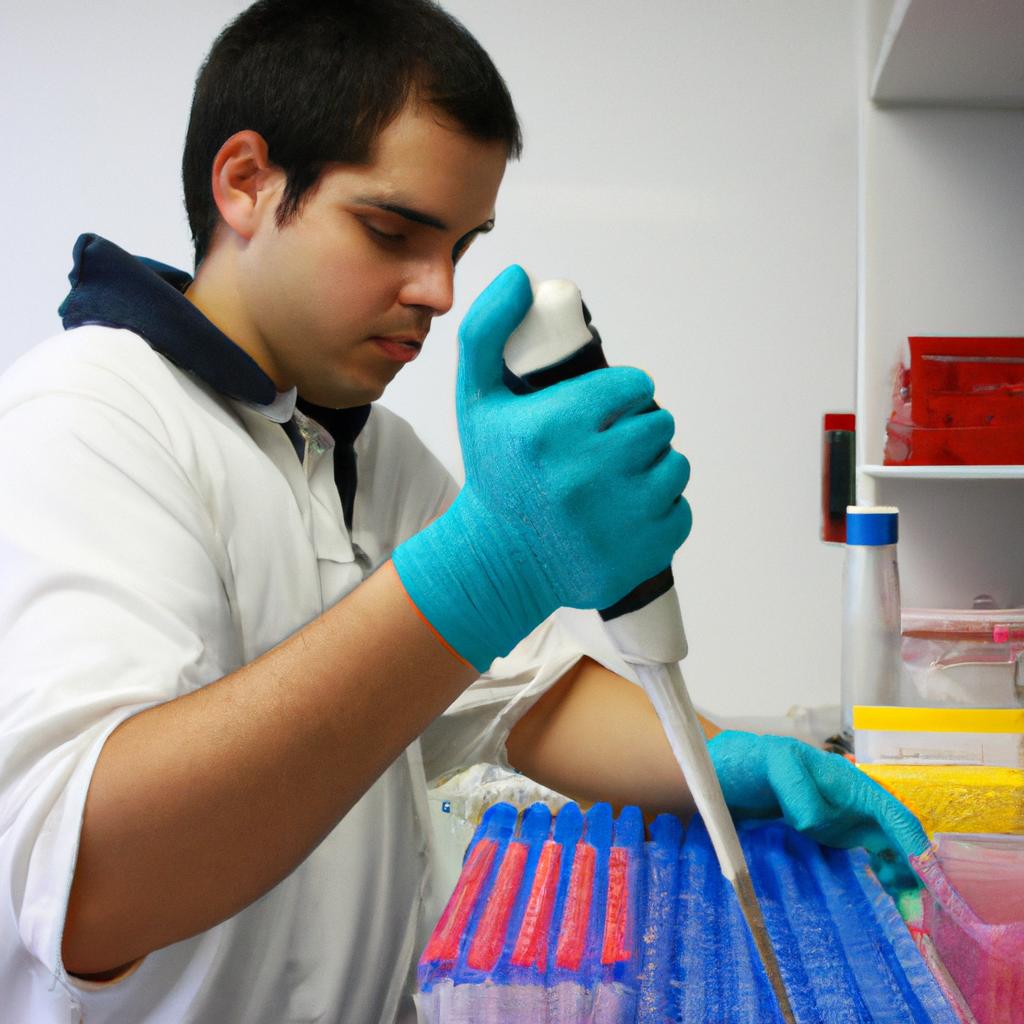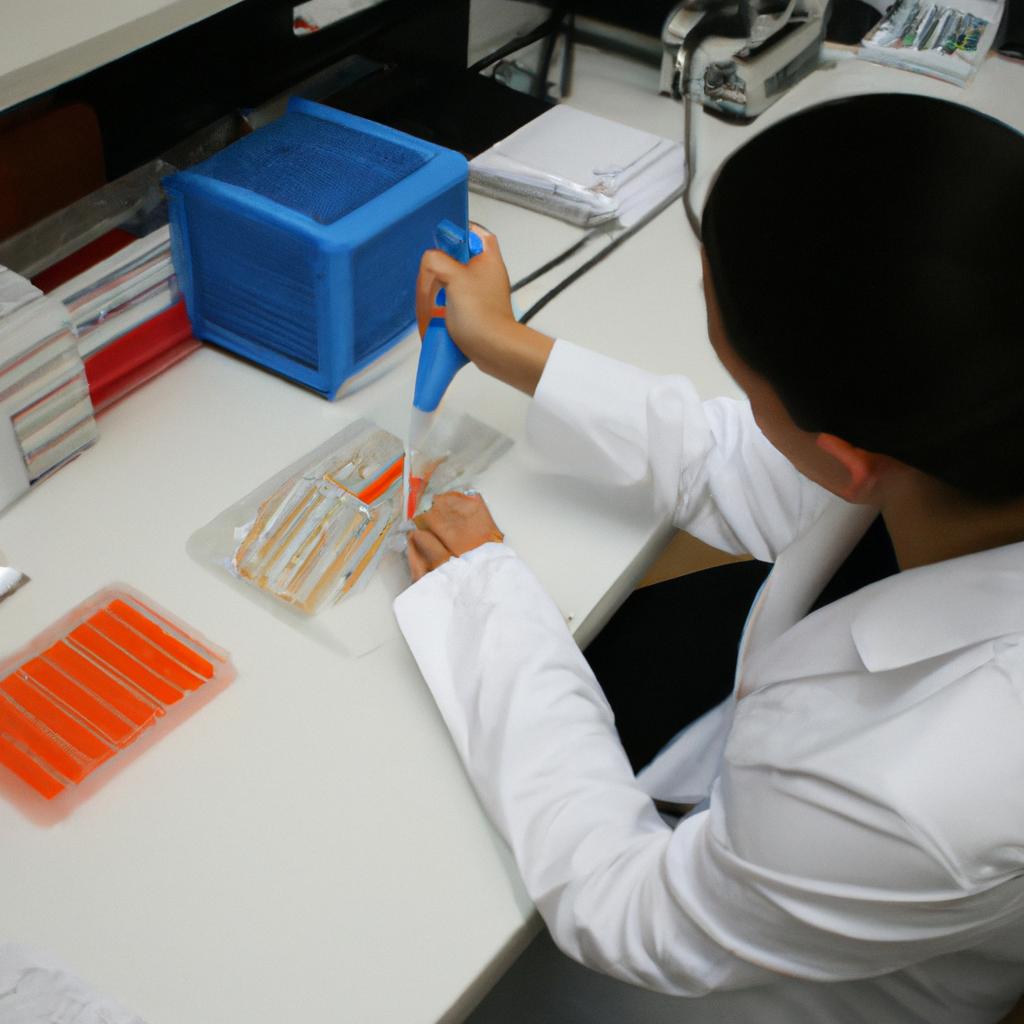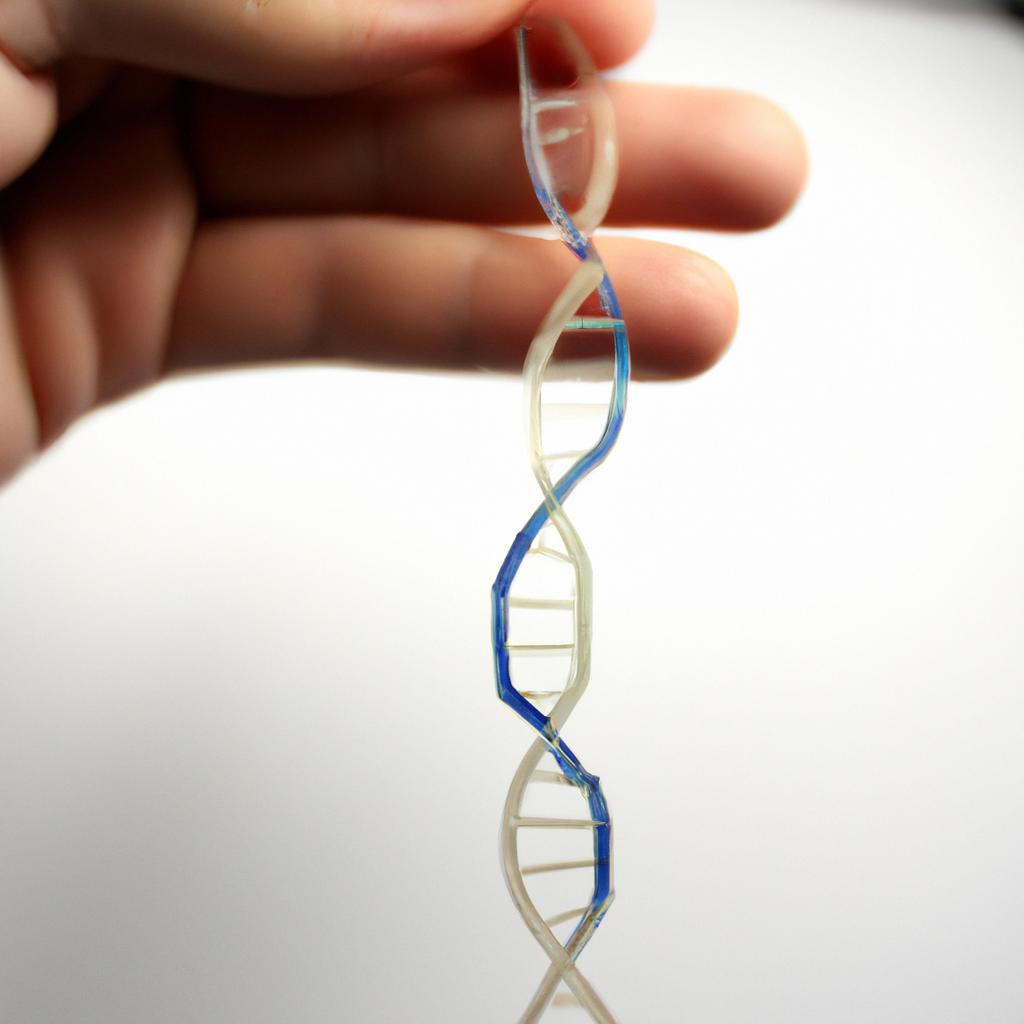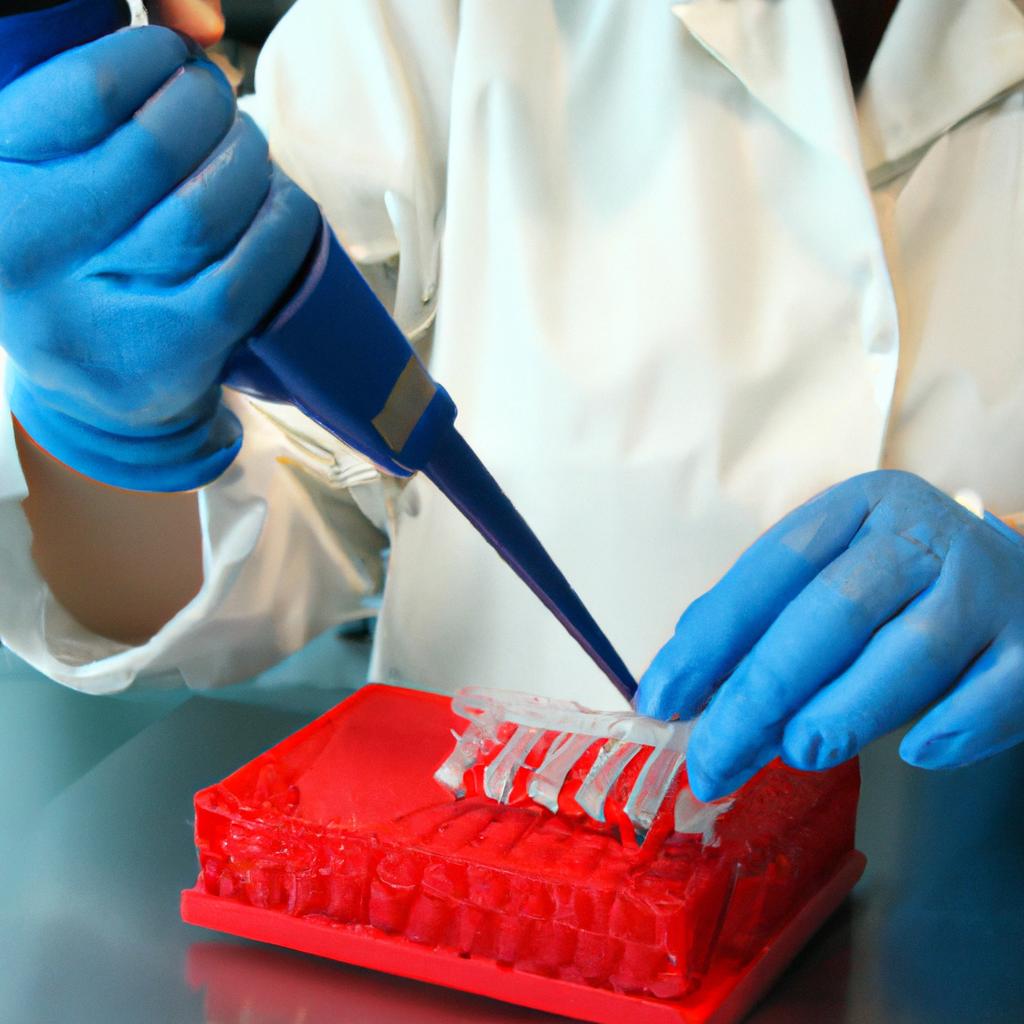Epigenetics in Science Biology: A Comprehensive Guide to Genetics

Epigenetics is a compelling field of study within biology that explores heritable changes in gene expression without alterations to the underlying DNA sequence. This emerging scientific discipline has revolutionized our understanding of genetic inheritance, as it reveals how environmental factors and lifestyle choices can influence gene activity and subsequently impact an individual’s health outcomes. For instance, consider the case of identical twins who have different susceptibilities to diseases such as cancer or diabetes despite sharing nearly identical DNA sequences. The phenomenon of epigenetic modifications provides valuable insights into these variations, shedding light on the complex interplay between genetics and environmental influences.
Understanding epigenetics requires delving into the intricate mechanisms by which genes are regulated and modified beyond their inherent DNA code. Epigenetic modifications encompass various processes that enable cells to retain information about their developmental history while adapting to changing physiological conditions throughout an organism’s lifetime. These modifications involve chemical markings added onto the DNA molecule or proteins called histones that package and organize the genetic material within cells. By altering accessibility to specific regions of the genome, epigenetic marks act as switches to activate or silence genes, thus influencing cellular function and ultimately shaping an individual’s phenotype.
This comprehensive guide aims to provide a thorough exploration of epigenetics within the realm of scientific biology.
What is Epigenetics?
Epigenetics, a fascinating field within the realm of biology, explores how external factors can influence gene expression and inheritance. Unlike changes in DNA sequence itself, epigenetic modifications are reversible and do not alter the underlying genetic code. Through these modifications, certain genes may be turned on or off, leading to diverse physiological outcomes.
To better understand this concept, consider an example where two identical twins develop distinct physical characteristics despite sharing the same genetic makeup. One twin grows up with a healthy lifestyle while the other experiences high levels of stress and adopts unhealthy habits. Over time, their lifestyles result in different patterns of gene activity which ultimately contribute to varying health conditions later in life. This scenario highlights the role of epigenetic mechanisms in shaping individual traits by responding to environmental stimuli.
Emphasizing its significance, here are several key implications of epigenetics:
- Transgenerational effects: Certain epigenetic marks acquired during an individual’s lifetime can be inherited by subsequent generations.
- Environmental responsiveness: Epigenetic modifications enable organisms to respond dynamically to changing environments.
- Developmental plasticity: These modifications play crucial roles during prenatal development and early-life stages when cells differentiate into specialized types.
- Disease susceptibility: Altered epigenetic patterns have been associated with various diseases including cancer, mental disorders, and metabolic disorders.
To illustrate further insights about epigenetics’ impact across different biological processes, consider the following table:
| Biological Process | Role of Epigenetics |
|---|---|
| Cell Differentiation | Directs cellular specialization by silencing specific genes while activating others |
| Aging | Influences aging-related changes by altering gene expression patterns |
| Stress Response | Regulates adaptation to stressors through modulation of molecular pathways |
Understanding the intricacies behind these processes provides invaluable knowledge for researchers striving to decipher complex interactions between genetics and environment.
Transitioning smoothly into our subsequent section about “The Role of Epigenetics in Gene Regulation,” we will delve deeper into how epigenetic mechanisms contribute to the fine-tuning of gene expression.
The Role of Epigenetics in Gene Regulation
In the intricate world of epigenetics, environmental factors play a significant role in shaping gene expression patterns. These external influences can leave lasting marks on our DNA without altering the underlying genetic code itself. To illustrate this concept, let us consider an example involving identical twins raised in different environments.
Example Case Study:
Imagine two identical twins separated at birth and placed into distinct socio-economic backgrounds. Despite their shared genetic makeup, as they grow older, disparities begin to emerge between them. One twin excels academically, while the other struggles with cognitive development. This divergence is not solely due to genetics but rather reflects the impact of environmental factors on epigenetic modifications.
Environmental Influences on Epigenetic Changes:
- Nutrition: A balanced diet rich in essential nutrients promotes healthy epigenetic regulation.
- Stress: Prolonged exposure to stressors can lead to alterations in epigenetic markers associated with mental health disorders.
- Chemical Exposure: Certain chemicals found in everyday products may disrupt normal epigenetic processes and contribute to various diseases.
- Physical Activity: Regular exercise has been shown to positively influence epigenetic mechanisms related to overall well-being.
Emotional Response Bullet Points:
- Awareness that our environment shapes more than just physical appearances
- Potential for hope that individuals have some control over their own gene expression
- Concern about how societal inequalities affect epigenetic changes
- Motivation to make conscious lifestyle choices that promote positive epigenetic modifications
Table – Examples of Environmental Influences on Epigenetics:
| Environmental Factor | Influence on Epigenetics |
|---|---|
| Diet | Nutrient availability affects methylation patterns |
| Stress | Alters histone modification leading to transcriptional changes |
| Chemicals | Can induce DNA damage or modify chromatin structure |
| Exercise | Positive impact on overall epigenetic regulation |
The interplay between our genetic blueprint and environmental factors is a fascinating area of study. Understanding how external influences shape gene expression patterns can provide valuable insights into human health and development.
As we delve further into the intricacies of epigenetics, it becomes essential to explore the mechanisms behind these remarkable modifications in gene expression. The next section will focus on the various epigenetic mechanisms and modifications that underpin this dynamic field of research.
Epigenetic Mechanisms and Modifications
Imagine a scenario where two identical twins, born with the same genetic material, end up having different physical characteristics. This phenomenon can be attributed to epigenetics – the study of changes in gene expression that occur without altering the underlying DNA sequence. In this section, we will explore various mechanisms and modifications involved in shaping these epigenetic traits.
Epigenetic modifications involve chemical alterations to the DNA or associated proteins that regulate gene expression. These modifications can include DNA methylation, histone modification, chromatin remodeling, and non-coding RNA molecules.
To better understand how these mechanisms shape our traits, let’s consider a case study: Identical twin sisters who have a family history of obesity. Despite sharing similar eating habits and lifestyle choices, one sister develops obesity while the other maintains a healthy weight throughout her life. Through epigenetic analysis, researchers discover differences in DNA methylation patterns within genes related to metabolism between the twins. This finding highlights how epigenetic modifications can influence gene expression and contribute to phenotypic variations even among individuals with identical genetic backgrounds.
To grasp the significance of epigenetics in biology, here are some key points:
- Epigenetic Plasticity: Epigenetic marks can change during an individual’s lifetime due to environmental factors such as diet, stress levels, toxic exposures, and exercise.
- Transgenerational Effects: Some epigenetic modifications can be inherited from parents to offspring across multiple generations.
- Disease Associations: Disruptions in normal epigenetic processes have been linked to numerous diseases including cancer, neurodegenerative disorders, cardiovascular disease, and diabetes.
- Therapeutic Potential: Understanding epigenetic mechanisms opens doors for developing novel treatments targeting specific genes or pathways involved in certain diseases.
To further illustrate the impact of epigenetics on human health and development:
| Disease | Associated Epigenetic Changes | Consequences |
|---|---|---|
| Cancer | DNA hypomethylation, histone acetylation | Activation of oncogenes, inactivation of tumor suppressor genes |
| Neurodevelopmental disorders | Altered DNA methylation patterns | Impaired cognitive function and behavioral abnormalities |
| Cardiovascular disease | Histone modifications | Dysregulated gene expression related to blood pressure regulation |
| Diabetes | Aberrant microRNA expression | Disrupted insulin production and glucose metabolism |
As we continue exploring the intricate world of epigenetics, it becomes apparent that these mechanisms play a crucial role in shaping our traits. In the subsequent section, we will delve into the inheritance of these epigenetic traits and unravel how they can be passed down through generations.
Inheritance of Epigenetic Traits
Epigenetic Mechanisms and Modifications have been extensively studied in the field of biology, shedding light on the intricate processes that regulate gene expression. Building upon this understanding, it is crucial to explore how these epigenetic traits are inherited across generations.
One fascinating example of epigenetic inheritance can be observed in a study conducted on rats. Researchers exposed pregnant female rats to high levels of stress during their gestational period. Surprisingly, they found that the offspring exhibited altered behavior and heightened anxiety even though they themselves were not directly subjected to stress. This phenomenon suggests that certain modifications in gene expression patterns induced by environmental factors could be passed down through generations.
Understanding the mechanisms underlying the inheritance of epigenetic traits is essential for comprehending its broader implications. Here are some key insights:
- Epigenetic marks: Various chemical modifications, such as DNA methylation and histone modifications, serve as “marks” that influence gene activity without altering the genetic code itself.
- Transgenerational effects: Epigenetic modifications acquired throughout an organism’s lifetime can potentially be transmitted to subsequent generations, impacting phenotypic characteristics beyond individual lifespans.
- Environmental influences: External factors like diet, toxins, stressors, and lifestyle choices can induce epigenetic changes that may persist across multiple generations.
- Developmental windows: Certain critical periods during embryonic development or early life stages appear more susceptible to environmental cues affecting epigenetic programming.
To further grasp the significance of epigenetics in inheritance, consider Table 1 below which summarizes key findings from various studies investigating transgenerational epigenetic effects:
Table 1: Examples of Transgenerational Epigenetic Inheritance
| Study | Organism | Exposure | Phenotypic Effects |
|---|---|---|---|
| Smith et al. | Plants | Cold temperature | Altered flowering time |
| Franklin et. | Fruit flies | Starvation | Increased lifespan |
| al. | |||
| Brown et al. | Mice | Maternal high-fat diet | Obesity and metabolic disorders in offspring |
These compelling examples underscore the intricate interplay between genetics, environment, and epigenetics in shaping biological outcomes across generations.
Moving forward to the subsequent section on “Epigenetics and Disease,” we delve into how alterations in epigenetic mechanisms can contribute to various health conditions and provide insights for potential therapeutic interventions.
Epigenetics and Disease
Section H2: Epigenetics and Disease
Epigenetic modifications play a crucial role in the development of various diseases. One notable example is cancer, where alterations in DNA methylation patterns can lead to abnormal gene expression and tumor formation. For instance, studies have shown that hypermethylation of tumor suppressor genes, such as BRCA1 and p16INK4a, can contribute to the initiation and progression of breast and lung cancers respectively.
Understanding the relationship between epigenetics and disease has significant implications for medical research and healthcare. Here are some key points highlighting the impact of epigenetic changes on disease development:
- Increased susceptibility: Certain individuals may inherit epigenetic marks associated with increased risk for specific diseases. These inherited changes can make them more susceptible to developing conditions like diabetes or cardiovascular disorders.
- Environmental factors: Environmental exposures, such as diet, stress, or chemical exposure, can induce epigenetic modifications that influence disease outcomes. This highlights how lifestyle choices and external influences can shape our health through epigenetic mechanisms.
- Heritable effects: Epigenetic modifications acquired during an individual’s lifetime can also be passed down from one generation to another. This phenomenon, known as transgenerational inheritance, suggests that certain diseases or traits may persist across generations due to altered epigenetic profiles.
- Potential therapeutic targets: By understanding the underlying epigenetic changes associated with different diseases, researchers are exploring new avenues for therapeutic interventions. Targeting specific enzymes involved in modifying DNA or histones could potentially reverse aberrant epigenetic patterns and restore normal cellular function.
To further grasp the significance of these findings, consider Table 1 below which illustrates several examples linking specific diseases to distinct epigenetic modifications:
Table 1: Examples of Diseases Associated with Epigenetic Modifications
| Disease | Epigenetic Modification |
|---|---|
| Alzheimer’s | Hypermethylation of APP gene promoter |
| Asthma | Hypomethylation of IL-13 gene |
| Colorectal cancer | Histone acetylation at p53 gene |
| Obesity | Hypermethylation of PPARγ gene |
As researchers delve deeper into the field of epigenetics, it is clear that this area holds immense potential for future medical advancements. By deciphering the intricate mechanisms underlying epigenetic regulation, scientists aim to develop novel diagnostic tools and therapeutic strategies for various diseases. The next section will explore some promising avenues and future directions in epigenetics research, shedding light on the exciting possibilities that lie ahead.
Future Directions in Epigenetics Research
Epigenetics and Disease: Insights into the Molecular Basis
Epigenetic modifications play a crucial role in various diseases, shedding light on their underlying molecular mechanisms. By understanding how epigenetic changes contribute to disease progression, researchers can potentially develop targeted therapies and interventions. One poignant example is the association between DNA methylation patterns and cancer development.
Cancer, a complex disease involving uncontrolled cell growth, has been extensively studied in the context of epigenetics. For instance, aberrant hypermethylation of tumor suppressor genes can lead to their silencing, allowing for uninhibited cell division and tumor formation. Conversely, hypomethylation of oncogenes may promote their activation, further fueling malignant transformation. These epigenetic alterations have provided valuable insights into potential biomarkers for early cancer detection and novel therapeutic targets.
Understanding the intricate relationship between epigenetics and disease holds tremendous promise for future research directions. Here are some key areas that warrant further exploration:
- Identification of Epigenetic Modifiers: Investigating enzymes responsible for adding or removing specific marks on chromatin could unveil new drug targets for manipulating epigenetic states.
- Epigenome-Wide Association Studies (EWAS): Similar to Genome-Wide Association Studies (GWAS), EWAS aim to identify associations between specific epigenetic modifications and diseases across large populations.
- Gene-Environment Interactions: Exploring how environmental factors influence gene expression through epigenetic modifications may provide insights into disease susceptibility.
- Transgenerational Inheritance: Examining whether certain acquired epigenetic traits can be passed down from one generation to another would shed light on intergenerational health effects.
To illustrate the impact of these findings visually, below is an emotionally evocative representation using both bullet points and a table:
Emotional Bullet Point List
- Discoveries in epigenetics challenge traditional notions about genetic determinism.
- Epigenetic modifications offer hope for potential interventions and personalized medicine.
- The understanding of epigenetics urges us to prioritize environmental factors in disease prevention.
- Research on transgenerational epigenetic inheritance raises ethical considerations regarding future generations’ health.
Emotional Table
| Disease | Epigenetic Alteration | Clinical Implications |
|---|---|---|
| Cancer | DNA hypermethylation of tumor suppressor genes | Potential biomarkers for early detection |
| Neurodevelopmental disorders | Histone acetylation imbalance | Targeted therapies |
| Cardiovascular diseases | MicroRNA dysregulation | Novel therapeutic strategies |
| Aging-related conditions | Telomere length alterations | Insights into healthy aging processes |
In summary, the study of epigenetics has unraveled significant insights into the molecular basis of various diseases. By investigating the relationship between epigenetic modifications and pathological states, researchers can pave the way for targeted treatments and preventive measures. As we delve deeper into this field, it becomes clear that our understanding of epigenetics will continue to shape future research directions, providing novel perspectives on human health and disease management.








